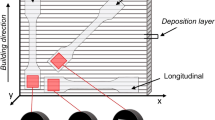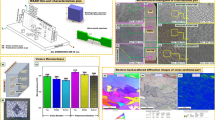Abstract
Various routes (unidirectional, cross, and three directions) normal and different speed rolling (DSR) are conducted on pure titanium sheet at 673 K and sequent 933 K annealing is followed. The results show that transverse direction (TD)-split double peak texture is kept during unidirectional rolling and a fiber basal texture is formed after cross and three-direction rolling. However, TD-split texture is preserved and rotates about 45° while the fiber basal texture is generated after cross and three direction rolling combining (DSTDR) DSR, respectively. This may be related to the changed strain path and induced shear deformation as well as thermal activation. Due to rotation of grains, the anisotropy of mechanical properties of Ti sheets decreases, especially in various DSR routes. Erichsen value is improved greatly in DSTDR specimens.









Similar content being viewed by others
References
Z.P. Zeng, Y.S. Zhang, and S. Jonsson: Deformation behaviour of commercially pure titanium during simple hot compression. Mater. Des. 30, 3105 (2009).
L.C. Tao, H.Y. Wu, J.C. Leong, and C.J. Fang: Flow stress behavior of commercial pure titanium sheet during warm tensile deformation. Mater. Des. 34, 179 (2012).
I. Lonardelli, N. Gey, H.R. Wenk, M. Humbert, S. Vogel, and L. Lutterotti: In situ observation of texture evolution during α → β and β → α phase transformations in titanium alloys investigated by neutron diffraction. Acta Mater. 55, 5718 (2007).
Z.N. Ismarrubie, A. Ali, T. Satake, and M. Sugano: Influence of microstructures on fatigue damage mechanisms in Ti-15-3 alloy. Mater. Des. 32, 1456 (2011).
N. Kotkunde, A.D. Deole, A.K. Gupta, S.K. Singh, and B. Aditya: Failure and formability studies in warm deep drawing of Ti–6Al–4V alloy. Mater. Des. 60, 540 (2014).
W. Kim, S. Yoo, and J. Lee: Microstructure and mechanical properties of pure Ti processed by high-ratio differential speed rolling at room temperature. Scr. Mater. 62, 451 (2010).
W.J. Kima, S.J. Yoo, H.T. Jeong, D.M. Kim, B.H. Choe, and J.B. Lee: Effect of the speed ratio on grain refinement and texture development in pure Ti during differential speed rolling. Scr. Mater. 64, 49 (2011).
H. Zhang, W.L. Cheng, J.F. Fan, B.S. Xu, and H.B. Dong: Improved mechanical properties of AZ31 magnesium alloy sheets by repeated cold rolling and annealing using a small pass reduction. Mater. Sci. Eng., A 637, 243 (2015).
X.S. Huang, K. Suzuki, Y. Chino, and M. Mabuchi: Texture and stretch formability of AZ61 and AM60 magnesium alloy sheets processed by high-temperature rolling. J. Alloys Compd. 632, 94 (2015).
X.S. Huang, K. Suzuki, A. Watazu, I. Shigematsu, and N. Saito: Mechanical properties of Mg–Al–Zn alloy with a tilted basal texture obtained by differential speed rolling. Mater. Sci. Eng., A 488, 214 (2008).
X.S. Huang, K. Suzuki, and Y. Chino: Improvement of stretch formability of pure titanium sheet by differential speed rolling. Scr. Mater. 63, 473 (2010).
N.P. Gurao, S. Sethuraman, and S. Suwas: Evolution of texture and microstructure in commercially pure titanium with change in strain path during rolling. Metall. Mater. Trans. A 44, 1497 (2012).
H. Nasiri-Abarbekoh, A. Ekrami, A.A. Ziaei-Moayyed, and M. Shohani: Effects of rolling reduction on mechanical properties anisotropy of commercially pure titanium. Mater. Des. 34, 268 (2012).
J.L. Milner, F. Abu-Farha, T. Kurfess, and V.H. Hammond: Effects of induced shear deformation on microstructure and texture evolution in CP-Ti rolled sheets. Mater. Sci. Eng., A 619, 12 (2014).
H. Zhang, G.S. Huang, L.F. Wang, H.J. Roven, and F.S. Pan: Enhanced mechanical properties of AZ31 magnesium alloy sheets processed by three-directional rolling. J. Alloys Compd. 575, 408 (2013).
G. Gottstein and T. Al Samman: Texture development in pure Mg and Mg alloy AZ31. Mater. Sci. Forum 495–497, 623 (2005).
K. Zhu, B. Bacroix, T. Chauveau, D. Chaubet, O. Castelnau: Texture evolution, and associated nucleation and growth mechanisms during annealing of a Zr alloy. Metall. Mater. Trans. A 40, 2423 (2009).
M.Q. Shi, Y. Takayama, T. Umetsu, H. Kato, H. Watanabe, H. Inoue: Microstructure refinement, and texture evolution of titanium by friction roll surface processing. Mater. Trans. 50, 210 (2009).
M.G. Glavicic, A.A. Salem, and S.L. Semiatin: X-ray line-broadening analysis of deformation mechanisms during rolling of commercial-purity titanium. Acta Mater. 52, 647 (2004).
H. Zhang, G.S. Huang, H.J. Roven, L.F. Wang, and F.S. Pan: Influence of different rolling routes on the microstructure evolution and properties of AZ31 magnesium alloy sheets. Mater. Des. 50, 667 (2013).
X.S. Huang, K. Suzukia, Y. Chino, and M. Mabuchi: Texture and stretch formability of AZ61 and AM60 magnesium alloy sheets processed by high-temperature rolling. J. Alloys Compd. 632, 94 (2015).
H. Zhang, G.S. Huang, L.F. Wang, and J.H. Li: Improved formability of Mg–3Al–1Zn alloy by pre-stretching and annealing. Scr. Mater. 67, 495 (2012).
H. Nasiri-Abarbekoh, R. Abbasi, A. Ekrami, and A.A. Ziaei-Moayyed: Notch-texture strengthening mechanism in commercially pure titanium thin sheets. Mater. Des. 55, 683 (2014).
J.M. Liu and S.S. Chou: Effect of anisotropy in commercial purity titanium on deep drawability at elevated temperatures. Mater. Sci. Technol. 16, 1037 (2000).
Y. Murayama, K. Obara, and K. Ikeda: Effect of twinning on deformation of textured commercially-pure Ti sheets under plane stress states. Mater. Trans. 34, 801 (1993).
X.S. Huang, K. Suzuki, A. Watazu, I. Shigematsu, and N. Saito: Improvement of formability of Mg–Al–Zn alloy sheet at low temperatures using differential speed rolling. J. Alloys Compd. 470, 263 (2009).
X.S. Huang, K. Suzuki, M. Yuasa, and Y. Chino: Microstructural and textural evolution of pure titanium during differential speed rolling and subsequent annealing. J. Mater. Sci. 49, 3166 (2014).
Q. Wang, Y.F. Yin, Q.Y. Sun, L. Xiao, and J. Sun: Gradient nano microstructure and its formation mechanism in pure titanium produced by surface rolling treatment. J. Mater. Res. 29, 569 (2014).
S.B. Yi, J. Bohlen, F. Heinemann, and D. Letzig: Mechanical anisotropy and deep drawing behavior of AZ31 and ZE10 magnesium alloy sheets. Acta Mater. 58, 592 (2010).
J. Adamus and P. Lacki: Possibility of the increase in titanium sheets’ drawability. Key Eng. Mater. 549, 31 (2013).
ACKNOWLEDGMENTS
This work is supported by National Natural Science Foundation of China (51504162), National Natural Science Foundation of China (51375328) and (51405500), Shanxi Province Science Foundation for Youths (2016021063), Chongqing Basic Frontier Research Program “Design, Manufacture and Performance Evolution of Light Alloy Automotive Components” (cstc2013jcyjC60001), Pre-research Foundation (9140A17040114KG01242), Fundamental Research Funds by Taiyuan University of Technology (tyut-rc201523a) and (2015QN011), and Research Project Supported by Shanxi Scholarship council of China (2015036).
Author information
Authors and Affiliations
Corresponding author
Rights and permissions
About this article
Cite this article
Wang, L., Zhang, H., Huang, G. et al. Formability and anisotropy of the mechanical properties in commercially pure titanium after various routes normal and different speed rolling. Journal of Materials Research 31, 3372–3380 (2016). https://doi.org/10.1557/jmr.2016.352
Received:
Accepted:
Published:
Issue Date:
DOI: https://doi.org/10.1557/jmr.2016.352




